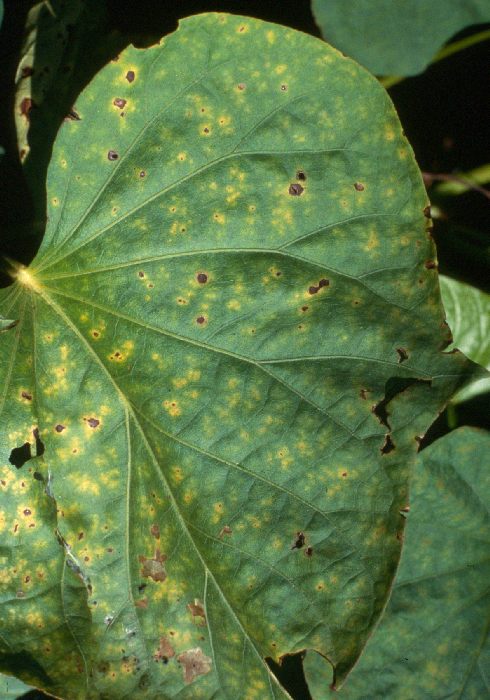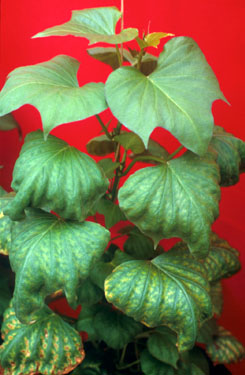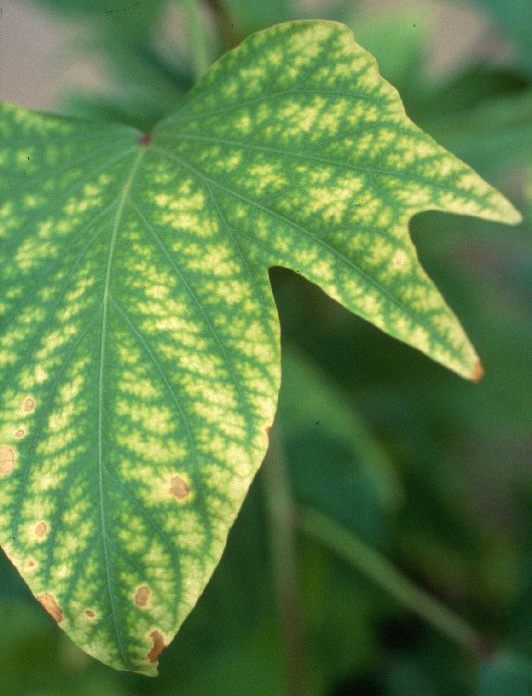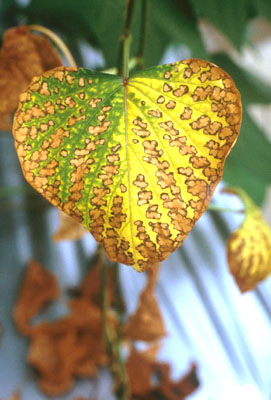|
Boron
(B) toxicity is most likely to arise on saline
and alkaline soils, following
overfertilisation with B fertiliser, or following the application of irrigation
water high in B. Low yields of irrigated sweetpotato in southern coastal Peru
have been attributed to a combination of salinity and B toxicity.
Sweetpotato
has been reported to be only moderately tolerant of B toxicity, but this
assessment was made according to the appearance of symptoms on sand-cultured
plants, and may not reflect yield reduction.
Boron
toxicity causes conspicuous necrotic lesions
in the interveinal areas of older
leaves, leading to premature senescence
and shedding of the leaves. Affected leaves are usually cupped downwards, or
curled under at the tip. In solution culture, symptoms may be evident on plants
suffering only a minor reduction in growth due to B toxicity, but in the field,
root damage may result in severe stunting and poor survival of cuttings.
In
some cultivars, initial symptoms may be the development of a pale green to
whitish interveinal chlorosis, but in
other cultivars necrotic spots may be
preceded by only a localised chlorosis, with the surrounding tissue remaining
green. Necrotic spots may be light brown, dark brown, or have a dark outline.
The necrotic tissue is brittle, and in some instances may drop out, leaving
"shot-holes".
Lesions are usually concentrated near the leaf margins and in
interveinal tissue midway between main veins, but may appear initially to be
more scattered. They may spread and coalesce to occupy most of the interveinal
and marginal tissue. However, in cultivars with deeply divided leaf blades, the
distribution may be less regular.
Leaf senescence proceeds rapidly, with the remaining live
tissue turning yellow, and necrosis spreading from the initial lesions over the
entire blade.
Researchers in Peru found considerable variation in tolerance
to B toxicity among cultivars of sweetpotato, but noted that the severity of
foliage damage was not related to the root yield of the cultivar.
Salinity may induce symptoms of necrotic lesions in
interveinal tissue, similar to those caused by B toxicity. However, the necrotic
lesions in the case of salinity are usually a dark, steel-grey colour and first
appear on the margins of older leaves, although as symptoms spread to younger
leaves, they become less marginal and more interveinal. Plants suffering from B
toxicity may develop interveinal chlorosis well in advance of necrotic lesions.
With salinity, chlorosis is uncommon except immediately surrounding the necrotic
lesions.
In the early stages of symptom development in some cultivars,
B toxicity may induce interveinal chlorosis similar to that of Mg deficiency.
The appearance on older leaves of discrete necrotic spots would distinguish B
toxicity from Mg deficiency.
Necrotic lesions, if produced with little preceding
chlorosis, may be mistaken for those caused by fungal pathogens, such as Alternaria
spp., Cercospora bataticola and Phyllosticta batatas. Fungal
lesions may be recognised by their random distribution on the leaf blade, not
showing a regular interveinal pattern. While fungal lesions may be more common
on older leaves, they do not show a consistent decrease in severity from the
oldest to younger leaves.
The critical concentration for B toxicity in the 7th to 9th
youngest leaf blades of sweetpotato has been found to lie between 220 and 350 mg
B/kg. Concentrations of 400-800 mg B/kg were associated with 30-50% growth
reductions, while concentrations from 1200 to more than 2000 mg B/kg were found
in severely affected plants. Index leaves from healthy plants usually contain
50-200 mg B/kg.
Hot water extraction is most frequently used to estimate the
concentration of plant-available B in soil. The threshold for B toxicity in
sweetpotato is in the order of 4 mg/kg hot water-extractable B, or approximately
0.15 mg/kg B in the soil saturation extract. However, cultivars may vary
considerably in their tolerance of excess B.
Cultural control
Use of low B concentration water if available. This may
possibly leach the excess B from the root zone.
Liberal application of N fertiliser, especially calcium nitrate.
Addition of lime and organic matter.
Cultivar tolerance
Sweetpotato genotypes with useful levels of tolerance, as well
as having good agronomic and quality characteristics have been identified
by the International Potato Center (CIP).
Bradford, G.R. 1966. Boron. In: Chapman, H.D.
(ed.) Diagnostic criteria for plants and soils. University of California,
Riverside. pp 33-61.
Chávez, R., Mendoza, H. and Espinoza, J. 1995.
Breeding sweetpotato for adaptation to arid and saline soils. CIP Circular,
August 1995, pp 2-7.
Landon, R.J. 1991) (ed.) Booker tropical
soil manual: a handbook for soil survey and agricultural land evaluation in the
tropics and subtropics. Booker Tate Ltd; Longman, London.
Olsen, S.R. 1972. Micronutrient interactions. In:
J.J. Mortvedt, P.M. Giordano and W.L. Lindsay (eds.), Micronutrients in
Agriculture. Soil Science Society of America Inc., Madison, Wisconsin, USA, pp
243-264.
O’Sullivan, J.N., Asher, C.J. and Blamey, F.P.C.1997. Nutrient Disorders of Sweet Potato.
ACIAR Monograph No. 48, Australian Centre for International AgriculturalResearch, Canberra, 136 p.
Contributed
by:
Jane O'Sullivan |
Characteristics and occurrence
Symptoms
Confusion with other symptoms
Diagnostic tests
Management
References

Interveinal chlorotic patches and necrotic spots on an older leaf,
due to boron toxicity (J. O'Sullivan).

Interveinal yellowing
progressing to brown lesions. Leaves may become cupped downward
(J.
O'Sullivan).

Interveinal
chlorosis and necrotic lesions toward leaf tip, cv. Hawaii (J. O'Sullivan).

Interveinal
and marginal necrotic spots spreading on older leaf, cv. Wanmun (J.
O'Sullivan). |

